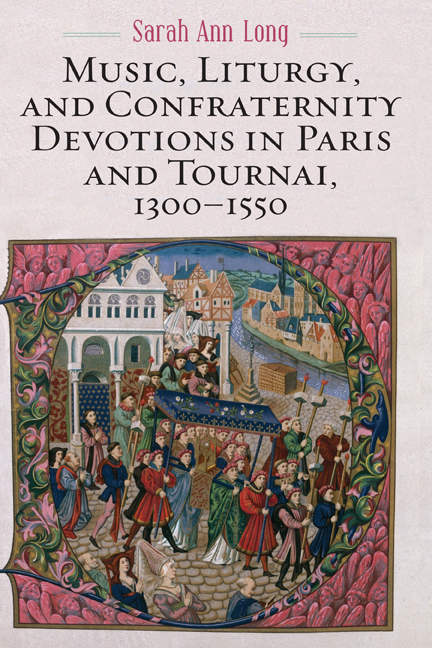Book contents
- Frontmatter
- Dedication
- Contents
- List of Illustrations
- Acknowledgments
- List of Abbreviations
- Editorial Procedures for Foreign Languages and Music Examples
- Note on Online Material
- Introduction
- 1 Confraternities and Popular Devotions to St. Barbara in Tournai
- 2 Relic Translation and Healing in Liturgies for St. Catherine and St. Nicholas in Paris
- 3 Historical Narratives and the Importance of Place in Masses for St. Sebastian
- 4 Compositional Practice, Networks, and the Dissemination of the Mass Ordinary in Confraternity Sources
- 5 The Role of the Parisian Book Production Community in the Perpetuation of Popular Devotions
- Conclusion
- Appendix 1 Sources
- Appendix 2 Inventories of Sources from Tournai
- Appendix 3 Scribal Hands and Gatherings in the Tournai Notary Confraternity Manuscripts
- Notes
- Bibliography
- Index of Chant and Polyphonic Compositions
- Index of Early Printed Liturgical Books
- Index of Manuscripts
- General Index
Appendix 2 - Inventories of Sources from Tournai
Published online by Cambridge University Press: 23 June 2021
- Frontmatter
- Dedication
- Contents
- List of Illustrations
- Acknowledgments
- List of Abbreviations
- Editorial Procedures for Foreign Languages and Music Examples
- Note on Online Material
- Introduction
- 1 Confraternities and Popular Devotions to St. Barbara in Tournai
- 2 Relic Translation and Healing in Liturgies for St. Catherine and St. Nicholas in Paris
- 3 Historical Narratives and the Importance of Place in Masses for St. Sebastian
- 4 Compositional Practice, Networks, and the Dissemination of the Mass Ordinary in Confraternity Sources
- 5 The Role of the Parisian Book Production Community in the Perpetuation of Popular Devotions
- Conclusion
- Appendix 1 Sources
- Appendix 2 Inventories of Sources from Tournai
- Appendix 3 Scribal Hands and Gatherings in the Tournai Notary Confraternity Manuscripts
- Notes
- Bibliography
- Index of Chant and Polyphonic Compositions
- Index of Early Printed Liturgical Books
- Index of Manuscripts
- General Index
Summary
This appendix records all the manuscript and printed liturgical books containing music that were used by confraternities at various institutions in Tournai through the end of the sixteenth century. Because musical sources from Tournai have not been the object of an in-depth study, sources used in the main sanctuary of the cathedral, as well as those used in other chapels at this institution, are included in the appendix with truncated descriptions. Within the inventories, all Mass ordinary chants are listed in the order in which they appear in the manuscript or printed book, along with a “C” number that has been assigned solely for the purposes of the present study. The appendix also takes special care to indicate sequences appearing outside of the Mass in these sources. The numbering system in this appendix corresponds to the numbers assigned to the sources in appendix 1, which are used for all comparison tables in the chapters and appendices throughout the present study.
Liturgical Books Used by Confraternities in Tournai
10. Archives et Bibliothèque de la Cathédrale de Tournai, Manuscript 12 (B-Tc A 12). 270 x 185 mm. Late fourteenth- or early fifteenth-century binding (a date determined based on the index of the source's contents, discussed in chapter 1), consisting of brown leather over wooden boards, with evidence of missing clasps. 1 unnumbered parchment flyleaf + 216 numbered parchment folios. Foliation in a modern hand beginning on the second parchment folio in pencil, using Arabic numerals written only on the recto of each leaf in the lower right-hand margin. Penwork initials, and use of red, blue, and yellow throughout. No illuminations. The music notation, which appears on red four-lined staves, consists primarily of a hybrid form commonly found in the southern Low Countries, which mixes elements of French and German neumes. There is also square chant notation on four-lined red staves throughout.
Antiphoner and gradual used by the Confraternity of the Notaries at the Cathedral of Tournai, with original contents and later additions dating from the thirteenth through sixteenth centuries. There is a card glued to the front of the book in the nineteenth century indicating the source's place of origin, “Cathedral de Tournay” [sic].
- Type
- Chapter
- Information
- Publisher: Boydell & BrewerPrint publication year: 2021



